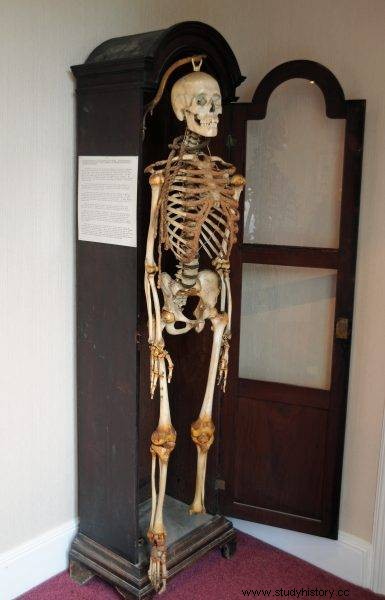A biting conscience can strongly influence a person's actions and decisions. And unusual behavior arouses the curiosity of others, leading to questions, analysis and new conclusions. Even questioning court sentences. This is what happened in the case of John Horwood, who was convicted of the murder of his beloved.
John was born in the early 1800s as the fifth son of nine children of Thomas and Phoebe Horwood. The family lived in Hanham, near Bristol. She led a relatively quiet life. However, everything changed by the passionate love that John fell for Eliza Balsom at the age of 16.
The couple knew each other from an early age, which was not unusual in such a small community. However, the feeling born of childhood friendship turned out to be one-sided. Unfortunately, Eliza did not know that by rejecting the young man's advances, she would awaken his dark side. Soon John's fascination turned into an unhealthy obsession. The boy began to persecute his beloved, provoking aggressive verbal and physical harassment, and even tried to pour sulfuric acid over her. Sooner or later a tragedy must have happened. In January 1821, John spotted Eliza walking with another young man and, in a fit of mad jealousy, threw a stone at her, hitting her temple.
Initially, the injuries did not seem serious - just a slight headache and a cut forehead. However, Eliza wisely opted for treatment at the Bristol Royal Infirmary, where she was looked after by Dr. Richard Smith. The seemingly harmless wound caused the girl to fever. On this basis, Smith began to suspect an infection and decided to perform a trepanation of the skull. During the procedure, an abscess was found that would ultimately be responsible for the patient's death four days after the operation.
Crime and Punishment
The first medical records on the cause of Eliza's death were prepared by Dr. Smith. According to him, the reason was unequivocal - the trauma suffered as a result of the attack. In an effort to quickly convict the guilty party of the crime, the doctor gave Horwood's name to the police, who immediately went to arrest him. Terrified, John resisted, threatening the officers and trying to escape . Unfortunately, this, along with his earlier behavior towards Eliza, did not put him in a favorable light.
The trial went fairly smoothly and swiftly, and Dr. Smith himself was among those arguing against Horwood. It was his testimony that was considered the most damning. John was sentenced to death by hanging.

Horwood's skeleton
A few days after the sentence was pronounced, crowds of people gathered in New Gaol to see the last moments of Horwood's life. The execution was so popular that the local authorities put up posters informing about the need to be careful in the crowd, as the slippery and steep banks of a nearby river could lead to the inadvertent death of spectators absorbed in the macabre spectacle.
After the execution of the sentence, the body of the condemned man was to be handed over to Dr. Smith for public autopsy for medical students and others. It was a common practice in the 19th century. It was believed that criminals sentenced to death should support the development of science, and they would best contribute to this by 'lending' their bodies. However, the story of Horwood's remains did not end with their autopsy.
190 years in "captivity"
John's friends did not want to allow the public dissection of him, so they decided to steal the man's body and bury it in Hanham. Dr. Smith probably suspected that this might happen, so he secretly expedited the transportation of the remains to the autopsy site.

Horwood's portrait taken during the trial
To better show Horwood's anatomy, his skin was removed, which was then tanned at the doctor's request, and then the files documenting John's crime, his trial and sentence were framed with it. This volume is now stored at the M Shed Museum in Bristol, along with the table on which Dr. Smith performed the autopsy. The book is decorated with an embossing in the shape of a gallows and a skull with crossbones and a Latin inscription Cutis Vera Johannis Horwood (The Real Leather of John Horwood). However, it was not the only remnant of the hanged man's body.
Smith also "adopted" John's skeleton, which he kept in his home until his death. Later it was donated to the hospital and then to the University of Bristol. Used for research purposes, it was unfortunately still marked by the judgment of 1821. How? His neck was decorated with a loop made of rope.
How the doctor treated the young man's body raised questions. In time, the trepanation of the skull he carried out on Eliza was examined again, and new reports and analyzes called into question the validity of the judgments of the time. According to the doctors, there was a high probability that Smith himself had killed the girl through a wrong procedure.
Horwood's remains finally got a dignified burial. Despite the passage of time, the family of the deceased did not forget about him. Mary Halliwell, a relative of John's brother, buried the skeleton of her ancestor. The funeral took place on April 13, 2011 at 1.30 pm. Exactly 190 years after his execution.
Bibliography
- Brooke-Hitching, The Madman's Library , Rebis Publishing House, 2020.
- Woźniak, Bookbinding. Books in human skin , Wybcza.pl, 03/11/2015.
- Ucińska, Human reading , focus.pl, June 20, 2012.
- Halliwell, An Unjust Hanging:The True Story of John Halliwell , Memoirs Publishing, 2012.
